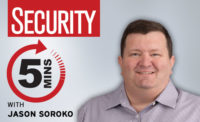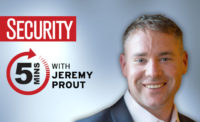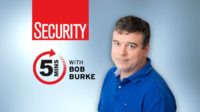5 minutes with Matt Voska - The importance of in-office security guards

Ensuring the safety of workers is the top priority for human resources (HR), whether that’s adhering to proper social distancing measures or following emergency response protocols. In today's divisive environment, how can HR departments leverage in-office security guards to keep employees safe?
Here, we talk to Matt Voska about the importance of in-office security guards and why security management technology is critical in helping HR leaders ensure workforce safety.
Security magazine: What is your title and background?
Voska: My current title is Chief Operating Officer at Bannerman Security. My interest and background in security really started on one of the most terrifying days of my life. Back in 2013, I was volunteering as a security guard for the Boston Marathon. That afternoon, two bombs went off near the race's finish line - one block away from where I was working. Even though I was there to make people feel safe, I felt powerless. It was so chaotic, and there was limited communication in the moments that followed. I honestly didn't know what to do. Then, over the next few days, it seemed like every three-letter government agency was there to investigate, but there was no standardized information on the ground.
Thankfully, they caught the bombers in just a few days, but I always wondered if they could have been caught sooner if information could have been shared more efficiently in the moment and in the days that followed. This experience is what made me think – there must be a better way to do this, and it's what inspired me to join Bannerman as COO in 2014. I wanted to build a software-enabled company with the vision that everyone deserves to be safe. Today, we help businesses hire physical security teams that use our workforce software to increase transparency and reporting, so the right information goes to the right person in real-time.
Security magazine: How can HR departments leverage in-office security guards to keep employees safe, especially in today’s divisive environment?
Voska: Keeping employees safe is no easy task. HR departments have a lot on their plates, and security guards can help ease a bit of the burden. A lot of HR’s job revolves around preparedness, and having security guards just adds an extra layer of protection and preparedness. In fact, studies have shown again and again that the presence of a security guard alone can deter crime. So, objectively, just having a guard around can reduce violence, decrease crime, and improve overall safety.
Security guards can also help de-escalate uncomfortable situations, like heated interpersonal issues or angry clients. They can help enforce new COVID-19 policies, like temperature checks, masks, and social distancing. They can also monitor employee behavior, patrol parking lots, and more. HR departments can’t possibly be everywhere all at once. When you’re dealing with your regular day-to-day on top of today’s divisive environment, a global pandemic, protests, and more, having a little extra help can be an indisputable tool for keeping employees safe.
Security magazine: As states continue to roll out reopening plans, why is security management technology critical in helping HR leaders ensure workforce safety?
Voska: The world normally moves quickly, but in the age of COVID-19, it moves very quickly. HR leaders have to be able to communicate with their security team efficiently to keep everyone safe. However, the security industry is notorious for being pretty low-tech. You still have guards talking to each other via text with minimal managerial oversight. There’s just a lot of antiquated technology in the security world, which ultimately leads to inadequate security that isn’t keeping up with the times. In the real world, outdated tech or no tech leads to issues like not knowing which guard is on duty or who to contact when problems arise.
For instance, let’s say during the first week of reopening, a member of your staff tests positive for COVID. You need to quickly clear everyone out of the building for sanitizing and simultaneously prevent anyone from coming in. You need to get your security team on the same page. However, you don’t know who’s on duty. So, you call your contact at the security company. They don’t answer, so you call again, still no answer. If you’re lucky, someone calls you back. They check the schedule and call the guards who are supposed to be on-duty, only to find out that they swapped schedules with some other guards, and the phone numbers on file for the guards who are supposed to be working aren’t working phone numbers.
So, your security guard contact advises you to physically locate the guards on duty to tell them what you need them to do. However, you go, and you can’t find them. You eventually give up when you realize your guards didn’t show up for work that day, and now you’re in the middle of a crisis – with no one to help.
What a nightmare, right? Security management software prevents this stuff from happening. In this same scenario, with security management technology, you learn someone has COVID and can immediately see who’s working, when they clocked in, get access to their contact information, and more. Within minutes you’re in contact with your security team working on a plan of action. In times like these, when quick action is often required, security management technology can be critical to keeping your workplace safe.
Security magazine: Why is employee safety and office security a growing priority/trend right now?
Voska: I think it’s a combination of factors. In the U.S., in 2019, there were more mass shootings than there were days in the year. Combine that with the almost 13,000 workplace sexual harassment charges every year plus the omnipresent threat of terrorism and the increasing number of annual natural disasters, and it’s easy to see why there’s a heightened level of stress surrounding workplace and public safety.
Even pre-COVID, there were these mass calls to increase workplace safety. We had Amazon workers protesting unsafe working conditions on Prime Day and McDonald’s workers jumping on the “Me Too” hashtag on social media and filing lawsuits for sexual harassment. Across the globe, employees were banding together and demanding safer work environments through public protests, social media movements, and more.
The whole issue of employee and office safety really hit a fever pitch when COVID broke out. Many companies were looking at profit and saying, “Hey I know there’s a pandemic, but you’ve got to come in.” In response, we saw this massive uprising of people saying, “It’s not safe, and I don’t and won’t return to work until it is.” 2020 has been a real power struggle with employees demanding safe working conditions, and I don’t think that’s going anywhere anytime soon.
I also think there’s been an emphasis on employee happiness for the last decade or so. They’ve done studies that say that employees have a greater output and stick around longer if they’re happy. Safety is part of that happiness equation. So, I think this trend towards improved office safety is also about increasing worker output and overall profitability too. Really, increasing employee safety and office security just makes sense for everyone. I think it’s a growing priority because there isn’t an ethical argument against providing a safe work environment. People have protested worker safety issues since the beginning of time. However, today, social media makes these plights much more visible, and as a result, companies have to answer that call in a way that they haven’t had to before.
Security magazine: What are some best practices when hiring office security guards? How do you know which security guard service is the right fit?
Voska: As far as best practices go, research is one of the best things you can do. Find a company that has experience working with businesses like yours. Be sure they have mostly positive online reviews, and make sure they have insurance and licensing. Also, be discriminate on price. The cheapest company isn’t usually the best option when it comes to security.
You also want to pay close attention to how communicative they are during the interview phase. If a security guard company isn’t picking up your calls now, they definitely won’t pick them up after you’ve hired them. Finally, ask about their technology and real-time reporting capabilities. You’re looking for a transparent company and one who allows you to have some level of control. You should be able to see guards’ schedules and incident reports and have proof that guards are showing up for work. You’ll need to trust your security company, and transparency, communication, and your level of control all contribute to that trust.
If you see any red flags, don’t ignore them. If you follow this general rubric, you should end up with a pretty good team. If not, don’t stick with a security company that isn’t working. Move on until you find one that truly makes your office safer.
Looking for a reprint of this article?
From high-res PDFs to custom plaques, order your copy today!





